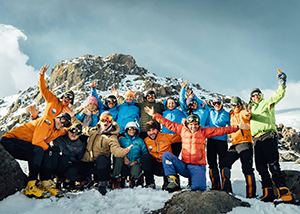
Group that climbed Cayambe in 2015. Image courtesy of ROMP.
On July 24-25, Karl Egloff, an elite athlete and one of the world’s fastest climbers, plans to climb to the top of Volcán Cayambe, Ecuador’s third highest mountain standing at almost 19,000 feet. The expedition, which is part of the Range of Motion Project’s (ROMP’s) 2016 Climbing for ROMP initiative, will bring global awareness to the unequal distribution of prosthetic care around the world.
Egloff will be leading a diverse group of individuals, including several ROMP patients, most of whom have never seen snow, let alone climbed a glacially covered volcano. They will climb alongside elite athletes, with disabilities and without, to the top of Cayambe, a challenging and dangerous climb due to glaciers, crevasses, and avalanches.
People of various backgrounds and abilities will join in solidarity with this global effort, which is planned for at least ten countries, and will climb for those who cannot. With this project, ROMP will raise awareness and funds for individuals who cannot afford or do not have access to prosthetic services. ROMP believes that prosthetic limbs and orthotic braces are not simply medical devices, but instruments of personal empowerment. By supplying prosthetic limbs and orthotic braces to those who do not have access to these services, ROMP aims to empower individuals to reach their full potential and help them move upward economically, socially, and physically.
“I think Climbing for ROMP is an inspiring project with the message for people to discover nature and to have personal objectives without excuses,” Egloff said. “Climbing for ROMP gives life, motivation, and a chance to fulfill their dreams.”
David Krupa, co-founder of ROMP adds, “We are in a unique position to leverage our own mobility to help amputees receive the prosthetic treatment and technology that they need to redefine their potential. This is our mission.”
For more information, visit www.rompglobal.org.
This article was adapted from information provided by ROMP.




